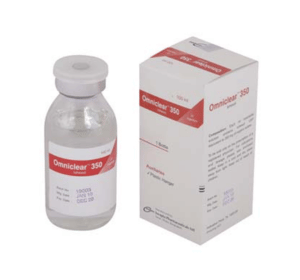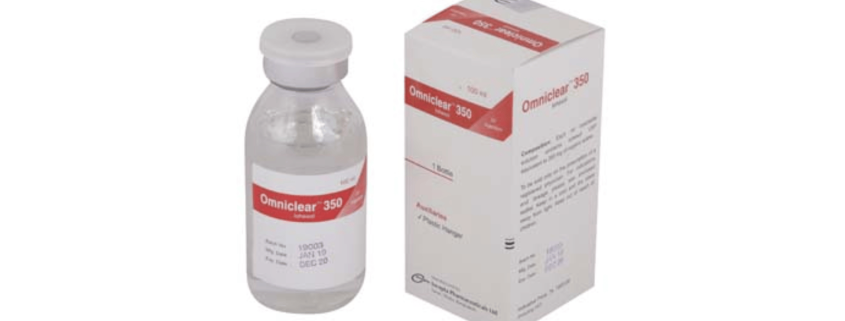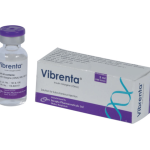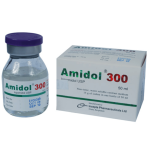Omniclear 350(Iohexol)

Therapeutic Group: Non Ionic Contrast Agent
Presentation
Omniclear 350 (50 ml) IV Injection: Each ml injectable solution contains Iohexol USP equivalent to 350 mg of organic iodine.
Omniclear 350 (100 ml) IV Injection: Each ml injectable solution contains Iohexol USP equivalent to 350 mg of organic iodine.
Description
Iohexol is a nonionic, water-soluble radiographic contrast medium. Iohexol blocks X-rays as they pass through the body, thereby allowing body structures not containing Iodine to be visualized. The degree of opacity produced by Iohexol is directly proportional to the total amount of the iodinated contrast agent in the path of the X-rays. The visualization of body structures is dependent upon the distribution and elimination of Iohexol.
Indications
Iohexol 350 is indicated in adults for angiocardiography, aortography, intravenous digital subtraction angiography of the head, neck, abdominal, renal and peripheral vessels, peripheral arteriography, and excretory urography. It is also indicated in pediatric patients for angiocardiography.
Dosage & Administration
Ventriculography
Adults: The usual adult volume for a single injection is 40 mL with a range of 30 mL to 60 mL. This may be repeated as necessary. When combined with selective coronary arteriography, the total administered volume should not exceed 250 mL (87.5 g Iodine).
Pediatrics: The usual single injection dose of Iohexol 350 is 1.25 mL/kg of body weight with a range of 1 mL/kg to 1.5 mL/kg. When multiple injections are given, the total administered dose should not exceed 5 mL/kg up to a total volume of 250 mL of Iohexol 350.
Selective Coronary Arteriography
The usual adult volume for right or left coronary arteriography is 5 mL (range 3 mL to 14 mL) per injection.
Aortic Root and Arch Study When Used Alone
The usual adult single injection volume is 50 mL, with a range of 20 mL to 75 mL.
Pulmonary Angiography
Pediatrics: The usual single injection dose is 1 mL/kg of Iohexol 350.
Combined Angiocardiographic Procedures
Multiple Procedures
Adults: The maximum total volume for multiple procedures should not exceed 250 mL of 350 mg lodine/mL.
Pediatrics: The maximum total dose for multiple injection procedures should not exceed 5 mL/kg up to a total volume of 250 mL of Iohexol.
Aortography and Selective Visceral Arteriography
Adults: The usual adult volume as a single injection is 50 mL to 80 mL for the aorta, 30 mL to 60 mL for major branches including celiac and mesenteric arteries, and 5 mL to 15 mL for renal arteries. Repeated injections may be performed if indicated, but the total volume should not exceed 250 mL of Iohexol 350.
Pediatrics: The usual single injection dose is 1.0 mL/kg of Iohexol 350 and should not exceed 5.0 mL/kg up to a total volume of 250 mL of Iohexol 350.
CT Scanning of the body
Head Imaging by Injection: 80 mL (28 gI) of Iohexol 350 (350 mgI/mL)
Body Imaging by Injection: 60 mL to 100 mL (21 gI to 35 gI) of Iohexol 350 (350 mgI/mL)
Digital Subtraction Angiography Intravenous Administration
The usual injection volume of Iohexol 350 for the intravenous digital technique is 30 mL to 50 mL. This is administered as a bolus at 7.5 to 30 mL/second using a pressure injector. The volume and rate of injection will depend primarily on the type of equipment and technique used. Frequently three or more injections may be required, up to a total volume not to exceed 250 mL (87.5 g Iodine).
Peripheral Angiography
The volume required will depend on the size, flow rate, and disease state of the injected vessel and on the size and condition of the patient, as well as the imaging technique used. The dosage recommended for use in peripheral angiography is as follows:
Aortofemoral runoffs: 20 mL to 70 mL of Iohexol 350 (350 mgI/mL)
Selective arteriograms (femoral/iliac): 10 mL to 30 mL of Iohexol 350 (350 mgI/mL)
Excretory Urography
Adults: Iohexol 350 at dosages from 200 mg Iodine/kg body weight to 350 mg Iodine/kg body weight have produced diagnostic opacification of the excretory system in patients with normal renal function.
Side Effects
Cardiovascular System: Arrhythmias including PVCs and PACs (2%), angina/chest pain (1%), and hypotension (0.7%). Others including cardiac failure, asystole, bradycardia, tachycardia, and vasovagal reaction were reported with an individual incidence of 0.3% or less.
Nervous System: Vertigo (including dizziness and lightheadedness) (0.5%), pain (3%), vision abnormalities (including blurred vision and photomas) (2%), headache (2%), and taste perversion (1%). Others including anxiety, fever, motor and speech dysfunction, convulsion, paresthesia, somnolence, stiff neck, hemiparesis, syncope, shivering, transient ischemic attack, cerebral infarction, and nystagmus were reported, with an individual incidence of 0.3% or less. Respiratory System: Dyspnea, rhinitis, coughing, and laryngitis, with an individual incidence of 0.2% or less. Gastrointestinal System: Nausea (2%) and vomiting (0.7%). Others including diarrhea, dyspepsia, cramp, and dry mouth were reported, with an individual incidence of less than 0.1%. Skin and Appendages: Urticaria (0.3%), purpura (0.1%), abscess (0.1%), and pruritus (0.1%).
Pediatrics
Cardiovascular System: Ventricular tachycardia (0.5%), 2:1 heart block (0.5%), hypertension (0.3%), and anemia (0.3%). Nervous System: Pain (0.8%), fever (0.5%), taste abnormality (0.5%), and convulsion (0.3%). Respiratory System: Congestion (0.3%) and apnea (0.3%). Gastrointestinal System: Nausea (1%), hypoglycemia (0.3%), and vomiting (2%). Skin and Appendages: Rash (0.3%).
Precautions
After parenteral administration of a radiopaque agent, competent personnel and emergency facilities should be available for at least 30 to 60 minutes since severe delayed reactions have occurred. Preparatory dehydration is dangerous and may contribute to acute renal failure in patients with advanced vascular disease, diabetic patients, and in susceptible non-diabetic patients (often elderly with preexisting renal disease), infants and small children. Patients should be well hydrated prior to and following administration of any contrast medium, including iohexol. Acute renal failure has been reported in diabetic patients with diabetic nephropathy and in susceptible non-diabetic patients following excretory urography. Therefore, careful consideration of the potential risks should be given before performing this radiographic procedure in these patients. Immediately following surgery, excretory urography should be used with caution in renal transplant recipients. A positive history of allergies or hypersensitivity does not arbitrarily contraindicate the use of a contrast agent where a diagnostic procedure is thought essential, but caution should be exercised. Premedication with antihistamines or corticosteroids to avoid or minimize possible allergic reactions in such patients should be considered and administered using separate syringes. Even though the osmolality of Iohexol is low compared to diatrizoate or iothalamate based ionic agents of comparable iodine concentration, the potential transitory increase in the circulatory osmotic load in patients with congestive heart failure requires caution during injection. These patients should be observed for several hours following the procedure to detect delayed hemodynamic disturbances. General anesthesia may be indicated in the performance of some procedures in selected adult patients; however, a higher incidence of adverse reactions has been reported in these patients, and may be attributable to the inability of the patient to identify untoward symptoms, or to the hypotensive effect of anesthesia which can reduce cardiac output and increase the duration of exposure to the contrast agent.
Angiography should be avoided whenever possible in patients with homocystinuria, because of the risk of inducing thrombosis and embolism. In angiographic procedures, the possibility of dislodging plaques or damaging or perforating the vessel wall should be borne in mind during the catheter manipulations and contrast medium injection. Test injections to ensure proper catheter placement are recommended. Selective coronary arteriography should be performed only in those patients in whom the expected benefits outweigh the potential risk. The inherent risks of angiocardiography in patients with chronic pulmonary emphysema must be weighed against the necessity for performing this procedure. When Iohexol is to be injected using plastic disposable syringes, the contrast medium should be drawn into the syringe and used immediately. If nondisposable equipment is used, scrupulous care should be taken to prevent residual contamination with traces of cleansing agents. Parenteral products should be inspected visually for particulate matter and discoloration prior to administration. If particulate matter or discoloration is present, it should not be used.
Use in Pregnancy & Lactation
Pregnancy: Pregnancy Category B. There are no adequate and well-controlled studies in pregnant women. Use during pregnancy only if the potential benefit justifies the potential risk to the fetus. Nursing Mothers: It is not known to what extent iohexol is excreted in human milk. Bottle feedings may be substituted for breast feedings for 24 hours following administration of Iohexol.
Drug Interaction
If iodine-containing isotopes are to be administered for the diagnosis of thyroid disease, the iodine-binding capacity of thyroid tissue may be reduced for up to 2 weeks after contrast medium administration. Thyroid function tests which do not depend on iodine estimation, eg, T3 resin uptake or direct thyroxine assays, are not affected. Many radiopaque contrast agents are incompatible in vitro with some antihistamines and many other drugs; therefore, no other pharmaceuticals should be admixed with contrast agents.
Over Dose
The adverse effects of overdosage are life-threatening and affect mainly the pulmonary and cardiovascular systems. The symptoms included: cyanosis, bradycardia, acidosis, pulmonary hemorrhage, convulsions, coma, and cardiac arrest. Treatment of an overdosage is directed toward the support of all vital functions, and prompt institution of symptomatic therapy.
Commercial Pack
Omniclear 350 (50 ml) IV Injection: Each box contains one bottle of 50 ml Iohexol solution, a leaflet and a plastic hanger.
Omniclear 350 (100 ml) IV Injection: Each box contains one bottle of 100 ml Iohexol solution, a leaflet and a plastic hanger.



